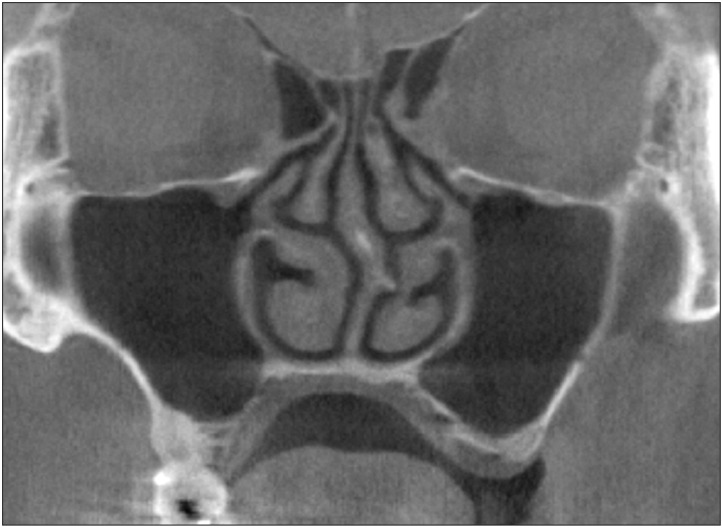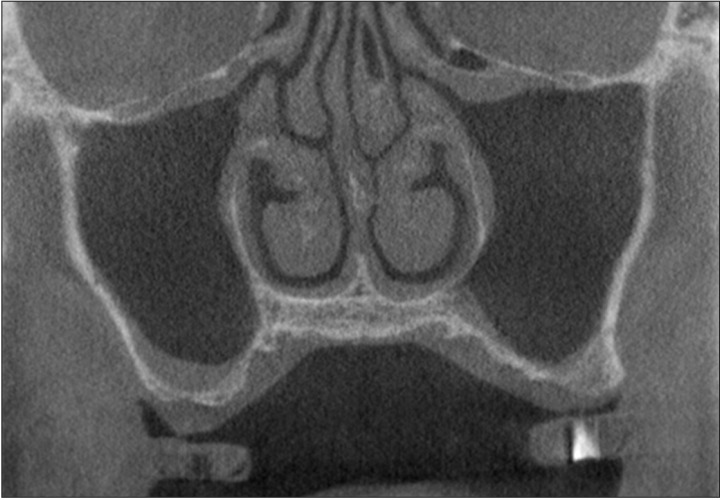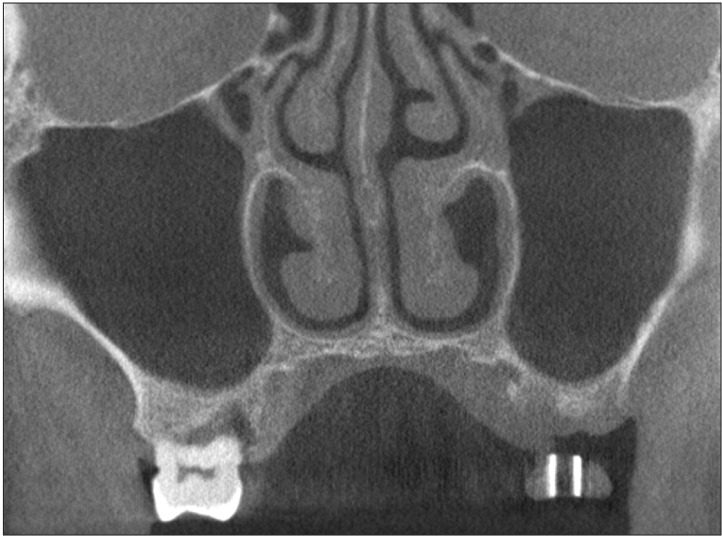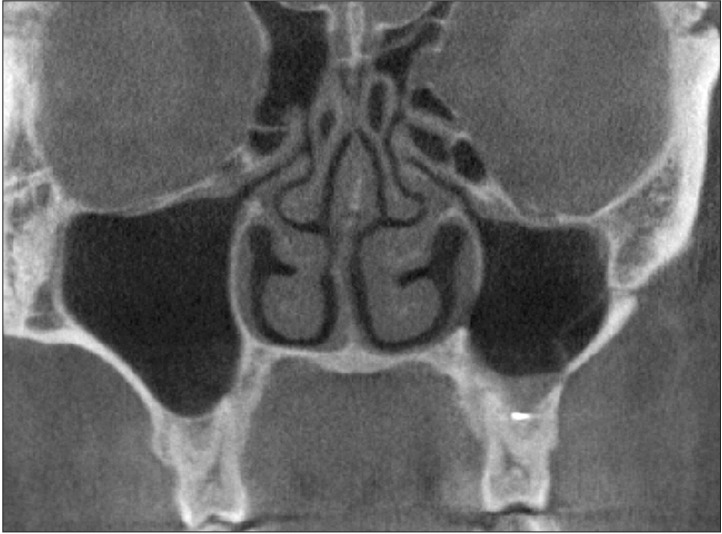J Korean Assoc Oral Maxillofac Surg.
2016 Oct;42(5):278-283. 10.5125/jkaoms.2016.42.5.278.
Correlations between anatomic variations of maxillary sinus ostium and postoperative complication after sinus lifting
- Affiliations
-
- 1Department of Oral and Maxillofacial Surgery, Wonkwang University Dental Hospital, College of Dentistry, Wonkwang University, Iksan, Korea. denhouse@wonkwang.ac.kr
- KMID: 2356254
- DOI: http://doi.org/10.5125/jkaoms.2016.42.5.278
Abstract
OBJECTIVES
The maxillary sinus mucosa is reported to recover to preoperative sterility after sinus floor elevation. However, when drainage of maxillary sinus is impaired, recovery can be delayed and maxillary sinusitis can occur. Therefore, in this study, we investigated the correlations between anatomic variants that can interrupt the ostium of the maxillary sinus and incidence of complication after sinus lifting.
MATERIALS AND METHODS
The subjects are 81 patients who underwent sinus lifting in Wonkwang University Dental Hospital (Iksan, Korea). Computed tomography (CT) images of the subjects were reviewed for presence of nasal septum deviation, anatomic variants of the middle turbinate, and Haller cells. Correlations between anatomic variations and occurrence of maxillary sinusitis were statistically analyzed.
RESULTS
Patients with anatomic variants of ostio-meatal units, such as deviated nasal septum, concha bullosa or paradoxical curvature of the middle turbinate, or Haller cells, showed a higher rate of complication. However, only presence of Haller cell showed statistically significant.
CONCLUSION
Before sinus lifting, CT images are recommended to detect anatomic variants of the ostio-meatal complex. If disadvantageous anatomic variants are detected, the use of nasal decongestants should be considered to reduce the risk of postoperative sinusitis.
Keyword
MeSH Terms
Figure
Reference
-
1. Raghoebar GM, Brouwer TJ, Reintsema H, Van Oort RP. Augmentation of the maxillary sinus floor with autogenous bone for the placement of endosseous implants: a preliminary report. J Oral Maxillofac Surg. 1993; 51:1198–1203. discussion 1203-5. PMID: 8229391.
Article2. Doud Galli SK, Lebowitz RA, Giacchi RJ, Glickman R, Jacobs JB. Chronic sinusitis complicating sinus lift surgery. Am J Rhinol. 2001; 15:181–186. PMID: 11453505.3. Misch CM. The pharmacologic management of maxillary sinus elevation surgery. J Oral Implantol. 1992; 18:15–23. PMID: 1289537.4. Drettner B. The permeability of the maxillary ostium. Acta Oto-Laryngologica. 1965; 60:304–314.
Article5. Bolger WE, Butzin CA, Parsons DS. Paranasal sinus bony anatomic variations and mucosal abnormalities: CT analysis for endoscopic sinus surgery. Laryngoscope. 1991; 101:56–64. PMID: 1984551.6. Bayram M, Sirikci A, Bayazit YA. Important anatomic variations of the sinonasal anatomy in light of endoscopic surgery: a pictorial review. Eur Radiol. 2001; 11:1991–1997. PMID: 11702133.
Article7. Timmenga NM, Raghoebar GM, Liem RS, van Weissenbruch R, Manson WL, Vissink A. Effects of maxillary sinus floor elevation surgery on maxillary sinus physiology. Eur J Oral Sci. 2003; 111:189–197. PMID: 12786948.
Article8. Yonkers AJ. Sinusitis--inspecting the causes and treatment. Ear Nose Throat J. 1992; 71:258–262. PMID: 1451672.9. Bertrand B, Eloy P. Relationship of chronic ethmoidal sinusitis, maxillary sinusitis, and ostial permeability controlled by sinusomanometry: statistical study. Laryngoscope. 1992; 102:1281–1284. PMID: 1405991.
Article10. Misch CE. Maxillary sinus augmentation for endosteal implants: organized alternative treatment plans. Int J Oral Implantol. 1987; 4:49–58. PMID: 3269837.11. Zimbler MS, Lebowitz RA, Glickman R, Brecht LE, Jacobs JB. Antral augmentation, osseointegration, and sinusitis: the otolaryngologist's perspective. Am J Rhinol. 1998; 12:311–316. PMID: 9805530.
Article12. Timmenga NM, Raghoebar GM, Boering G, van Weissenbruch R. Maxillary sinus function after sinus lifts for the insertion of dental implants. J Oral Maxillofac Surg. 1997; 55:936–939. discussion 940. PMID: 9294502.
Article13. Timmenga NM, Raghoebar GM, van Weissenbruch R, Vissink A. Maxillary sinusitis after augmentation of the maxillary sinus floor: a report of 2 cases. J Oral Maxillofac Surg. 2001; 59:200–204. PMID: 11213989.
Article14. Stammberger H. Endoscopic endonasal surgery--concepts in treatment of recurring rhinosinusitis. Part II. Surgical technique. Otolaryngol Head Neck Surg. 1986; 94:147–156. PMID: 3083327.
Article15. Jensen OT, Shulman LB, Block MS, Iacono VJ. Report of the sinus consensus conference of 1996. Int J Oral Maxillofac Implants. 1998; 13(Suppl):11–45. PMID: 9715571.16. Bhattacharyya N. Bilateral chronic maxillary sinusitis after the sinus-lift procedure. Am J Otolaryngol. 1999; 20:133–135. PMID: 10203163.
Article17. Zinner ID, Small SA. Sinus-lift graft: using the maxillary sinuses to support implants. J Am Dent Assoc. 1996; 127:51–57. PMID: 8568098.
Article18. Torretta S, Mantovani M, Testori T, Cappadona M, Pignataro L. Importance of ENT assessment in stratifying candidates for sinus floor elevation: a prospective clinical study. Clin Oral Implants Res. 2013; 24:57–62.
Article19. Laine FJ, Smoker WR. The ostiomeatal unit and endoscopic surgery: anatomy, variations, and imaging findings in inflammatory diseases. AJR Am J Roentgenol. 1992; 159:849–857. PMID: 1529853.
Article20. Scribano E, Ascenti G, Cascio F, Racchiusa S, Salamone I. Computerized tomography in the evaluation of anatomic variations of the ostiomeatal complex. Radiol Med. 1993; 86:195–199. PMID: 8210525.21. Aust R, Drettner B. The functional size of the human maxillary ostium in vivo. Acta Otolaryngol. 1974; 78:432–435. PMID: 4451093.
Article22. Stierna P, Söderlund K, Hultman E. Chronic maxillary sinusitis. Energy metabolism in sinus mucosa and secretion. Acta Otolaryngol. 1991; 111:135–143. PMID: 2014749.
Article23. Arslan H, Aydinlioğlu A, Bozkurt M, Egeli E. Anatomic variations of the paranasal sinuses: CT examination for endoscopic sinus surgery. Auris Nasus Larynx. 1999; 26:39–48. PMID: 10077255.
Article24. Fadda GL, Rosso S, Aversa S, Petrelli A, Ondolo C, Succo G. Multiparametric statistical correlations between paranasal sinus anatomic variations and chronic rhinosinusitis. Acta Otorhinolaryngol Ital. 2012; 32:244–251. PMID: 23093814.25. Ameri AA, Eslambolchi A, Bakhshandeh H. Anatomic variants of paranasal sinuses and chronic sinusitis. Iran J Radiol. 2005; 2:121–124.26. Nouraei SA, Elisay AR, Dimarco A, Abdi R, Majidi H, Madani SA, et al. Variations in paranasal sinus anatomy: implications for the pathophysiology of chronic rhinosinusitis and safety of endoscopic sinus surgery. J Otolaryngol Head Neck Surg. 2009; 38:32–37. PMID: 19344611.27. Zinreich SJ, Kennedy DW, Rosenbaum AE, Gayler BW, Kumar AJ, Stammberger H. Paranasal sinuses: CT imaging requirements for endoscopic surgery. Radiology. 1987; 163:769–775. PMID: 3575731.
Article28. Pignataro L, Mantovani M, Torretta S, Felisati G, Sambataro G. ENT assessment in the integrated management of candidate for (maxillary) sinus lift. Acta Otorhinolaryngol Ital. 2008; 28:110–119. PMID: 18646572.
- Full Text Links
- Actions
-
Cited
- CITED
-
- Close
- Share
- Similar articles
-
- Surgical Anatomy around the Maxillary Sinus Ostium in Cadavers
- Anatomic Variations of the Paranasal Sinus in Children with Chronic Sinusitis
- Treatment of dental implant-related maxillary sinusitis with functional endoscopic sinus surgery in combination with an intra-oral approach
- Closure Of Oro-Antral Fistula Using Sinus Lifting And Skin Graft In Maxillary Malignant Cases: Case Report
- Maxillary Sinus Mucocele Secondary to Organized Hematoma





